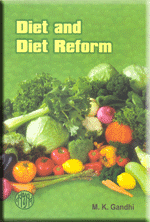
P.O. SEVAGRAM, DIST.WARDHA 442102, MS, INDIA. Phone: 91-7152-284753
FOUNDED BY MAHATMA GANDHI IN 1936
DIET AND DIET REFORM

DIET AND DIET REFORM
Table of Contents
PART-I
- SECTION I: General
- My Faith In Vegetarianism
- The Moral Basis of Vegetarianism
- Diet For Brahmacharya
- Green and Dietetic Ahimsa
- 'Food Faddists'
- Unfired Food Experiment
- Unfired Food
- Unfired Food
- Unfired Food
- National Food
- Minimum Diet
- For Four Rupees A Month
- A Talk to Village Workers
- Minimum Diet
- Plea for More Fruits
- Carrion-eating
- SECTION II : Rice, Wheat and Gur
- SECTION III : Soya Beans and Ground-nuts
- SECTION IV : Green Leaves, etc.
- SECTION V : Milk
- SECTION VI : Ghee and Oil
PART-II
- SECTION I : General
- Precautions Against Ills of The Season (M.D.)
- Dietetic Changes (M.D.)
- Mortification of The Flesh (M.D.)
- Vitamins - I (P. C. Ghosh)
- Vitamins - II (P. C. Ghosh)
- Physiological Basis of Nutrition
- Are you acid? (H. C. Menkel)
- What And How Much To Eat? (H. C. Menkel)
- Question on Diet (H. C. Menkel)
- Improved Diets (A. K.)
- Place of Cereals in Food (I. Amin)
- An Experiment in National Diet (Pyarelal)
- Revealing Figures (A. K.)
- SECTION II : Rice, Wheat and Gur
- The Miracle of Unpolished Rice (M.D.)
- Unpolished v. Polished Rice (Prof. Basu)
- Saving Cereals (D. K. Gupta)
- Useful Suggestion (M. A. Chadray)
- White v. Brown Sugar (M. D.)
- The Havoc of Sugar (M. D.)
- Bad Teeth and Refined Carbohydrates
- Potentialities of Palm Jaggery (Gajanan Naik)
- Nira - A Nutritious Beverage (Gajanan Naik)
- SECTION III : Soya Beans and Ground-nuts
- Warning against Soya Beans (M. D.)
- Soya Beans (M.D.)
- Soya Bean Recipes
- A Soya Bean Book (M. D.)
- The Utility of The Ground-nut (A. K.)
- SECTION IV : Fruit
- The Merit of Amla (A. K.)
- SECTION V : Milks
- Kimmed Milk and Buttermilk (W. R. Aykroyd and S. C. Dasgupta)
- SECTION VI : Ghee And Oil
- Edible Oils (P. C. Ghosh)
- Blindness At A Price (J. C. Kumarappa)
- Nakali Ghee (J. C. Kumarappa)
- SECTION VII : Tea
- Another Rising Menance (J. C. Kumarappa)
- Non-English Words With Their Meanings
About This Book
Written by : M. K. Gandhi
Edited by : Bharatan Kumarappa
First Edition : 5,000 copies, July 1949
ISBN : 81-7229-062-4
Printed and Published by : Jitendra T. Desai
Navajivan Mudranalaya,
Ahemadabad-380014
India
© Navajivan Trust, 1949
Download
Chapter 24: Soya Beans
It has been found that soya beans can be cooked whole and eaten like any other beans. Shri Narhar Bhave of Baroda, who has given his three gifted and gentle sons, Vinoba, Balkrishna and Shivaji to national service, is himself a careful observer, 61 years old. He is living almost wholly on milk and 6 ounces of soya beans and is keeping perfect health and strength. He is of opinion that soya beans help him to avoid constipation which milk alone or milk taken in combination with cereals and vegetables could not do. Soya beans have in his opinion helped him also to avoid flatulence which other pulses or milk produced. He has come to this conclusion after an unbroken experience of over ten months. I may add that Shri Bhave used to suffer from gout and corpulence and had a trace of diabetes. He got rid of this triple disability by mere careful dieting. In imitation of Shri Bhave the inmates of Maganwadi including me have been trying soya beans for the last few days. It is too early yet to pronounce any opinion for ourselves. Each inmate gets a heaped dessert spoonful per day. This is how the beans are cooked. Clean the beans of foreign particles or dirt. Wash in cold water and soak at least for twelve hours, and not more than eighteen and drain off superfluous water. Put these beans in boiling water and cook for fifteen minutes on a quick fire. No salt or soda to be added while cooking. Salt may be added after. At Maganwadi we steam them for two hours.
Let those who are interested in food reform from the poor man's point of view, try the experiment. It should be remembered that soya beans are a most nutritious diet. It stands at the top of all the known articles of diet because of its low percentage of carbohydrates and high percentage of salts, protein and fat. Its energy value is 2,100 calories per lb. against 1,750 of wheat and 1,530 of gram. It contains 40 per cent of protein and 20.3 per cent of fat against 19 and 4.3 respectively of gram and 14.8 and 10.5 of eggs. Therefore no one should take soya beans in addition to the usual protein and fatty foods. The quantity, therefore, of wheat and ghee should be reduced and dal omitted altogether, soya beans being themselves a highly nutritious dal.
Harijan,
19-10-1935